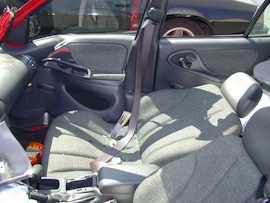 Seats play an important role in keeping motor vehicle occupants protected during a collision. A seat should be designed in such a manner as to reduce or eliminate as much as practical, the risks associated with foreseeable collisions. There are several ways in which a defective seat can cause injuries or even death in a motor vehicle crash:
Seats play an important role in keeping motor vehicle occupants protected during a collision. A seat should be designed in such a manner as to reduce or eliminate as much as practical, the risks associated with foreseeable collisions. There are several ways in which a defective seat can cause injuries or even death in a motor vehicle crash:
- Defective seat backs. Sometimes a seat back cannot withstand the forces of an occupant’s pressing against it in a crash, and the seat will bend or break rearward into a reclined position. If a seat collapses backwards during a collision, the seat’s occupant is no longer protected by his seat belt or his air bag, and can be thrown into the back seat or even ejected through the rear of the vehicle. Therefore, a front seat occupant whose seat back fails during a collision is at risk of head injury, spinal injury (including paralysis) or even death. Front seat occupants are not the only passengers at risk of injury when a seat back fails. Children, even when properly riding in car seats, can be injured or killed when a failed front seat back or a front seat passenger slams into them during a collision. When a driver’s seat back fails, the driver can lose control of the vehicle and cause a multi-vehicle collision. [Are you referring to a driver’s seat back spontaneously failing for no reason? Otherwise, isn’t it already out of control, hence the accident?]
- Inadequate head rests. Seats which have no head rest, or a head rest which does not offer adequate protection, can increase a passenger’s chances of head or neck injuries during a crash.
- Defective seat tracks. If the track on which a seat moves forward and backward is not strong enough, during a collision the seat may suddenly move either all the way forward or all the way backward under the crash forces. This rapid movement can cause head and neck injuries, including paralysis and soft tissue brain injuries, as well as death. The movement can also slam a passenger into the dash, an inflating air bag or another vehicle component, causing severe injuries or death. If the seat moves rearward under collision forces, it can also hurt or kill passengers sitting behind the moving seat.
In spite of the fact that seats are a significant safety feature in a motor vehicle, most vehicle seats present a significant safety hazard. Seat failures could be ascertained, isolated and fixed with adequate testing. However, motor vehicle manufacturers and component manufacturers have not conducted adequate tests to prevent seat failure in current designs. Safer, economically feasible, alternative designs for seats have been available for years.
A defective motor vehicle seat can and often does cause the vehicle occupants to suffer spinal cord injuries, which may result in quadriplegia, paraplegia or paralysis. Traumatic brain injury and death can also result.
If you or a loved one has been injured in an accident in which a seat or seat back did not perform properly, contact the experienced lawyers of Wolff Ardis, P.C. to help you investigate.







